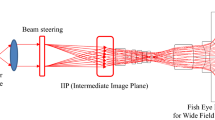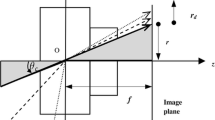Abstract
As camera technology develops, products have improved and people have an increasing demand for visual quality. To increase the field of view, many zooming modules have been designed, which has raised the cost of optic components, increased the amount of calculation required, and complicated image processing technology. To date, dashcam lenses are primarily a compensatory design that cannot autozoom. Developing technology with various focuses for use on different roads has become a critical topic for autopilot development. Possibilities include using a short focus on general roads and using a long focus for freeways. Dashcam lens design requires the ability to cover wide angles. The concept behind wide-angle zooming lenses is that when the focal length is the shortest, the widest monitoring range is achieved. To observe a point at a far distance, we can use optical zoom to increase the focal length, thereby enabling a view into the distance. At this time, the angular field of view is sacrificed. However, a reduction of the angular field of view leads to a reduction of distortion, which subsequently reduces the complexity of back-end image processing and leads to clearer images. The design in this study references the wide-angle lens patent US.20090080093 (Ning in Compact fisheye objective lens, U.S., Patent No. 20090080093, 2011) of Alex Ning, whose optical system consists of six spherical lenses. The angular field of view reached 170°. The total system length is 18 mm, and F/# is 3. The system focus is 1.652 mm. Four groups of liquid lenses were placed in this wide-angle lens. Altering the curvature and thickness of the liquid lenses changes the course of light and forms a new angular field of view. This system consists of three zoom settings, with fields of view being 170°, 160°, and 150°, respectively. The F/# was 2.4. The modulation transfer function at a spatial frequency of 1801 p/mm reached 6%, 0%, and 27%, respectively. F-Theta was controlled within ± 10%. The spot size was smaller than 4 μm, and the field curvature was smaller than ± 0.02 mm. The liquid lenses were successfully introduced into the wide-angle lens to achieve optical zoom without using a conventional mobile mechanical structure.
















Similar content being viewed by others
References
Beck C (1925) Apparatus to photograph the whole sky. J Sci Instrum 2:135–139. https://doi.org/10.1088/0950-7671/2/4/305
Berge B, Peseux J (2000) Variable focal lens controlled by an external voltage: an application of electrowetting. Eur Phys J E 3:159–163. https://doi.org/10.1007/s101890070029
Blum M, Büeler M, Grätzel C, Aschwanden M (2011) Compact optical design solutions using focus tunable lenses. Proc SPIE 8167:81670W. https://doi.org/10.1117/12.897608
Brauer-Burchardt VK (2001) A new algorithm to correct fisheye-and strong wideangle-lens-distortion from single images. Proc IEEE Int Conf Image Process 1:225–228. https://doi.org/10.1109/ICIP.2001.958994
Dong L, Agarwal AK, Beebe DJ, Jiang H (2006) Adaptive liquid microlenses activated by stimuli-responsive hydrogels. Nature 442:551–554. https://doi.org/10.1038/nature05024
Edmund Optics Inc (2014) Imaging resources guide. http://www.edmundoptics.com.tw/resources/application-notes/imaging/resolution/
Fang YC, Tsai CM (2008) Miniature lens design and optimization with liquid lens element via genetic algorithm. J Opt A Pure Appl Opt 10:075304. https://doi.org/10.1088/1464-4258/10/7/075304
Fang YC, Tsai CM, Chung CL (2011) A study of optical design and optimization of zoom optics with liquid lenses throughmodified genetic algorithm. Opt Express 19:16291–16302. https://doi.org/10.1364/OE.19.016291
Feng W, Zhang B, Roning J, Cao Z, Zong X (2011) An embedded omnidirectional vision navigator for automatic guided vehicles. Proc. SPIE 7878:1–12. https://doi.org/10.1117/12.872281
Hao Q, Cheng X, Du K (2013) Four-group stabilized zoom lens design of two focal-length-variable elements. Opt Exp 21:7758–7767. https://doi.org/10.1364/OE.21.007758
Hill R (1926) A lens for whole sky photography. Proc Opt Conv 2:878–883
Huang Z, Bai J, Hou X (2010) A multi-spectrum fish-eye lens for rice canopy detecting. Proc SPIE. https://doi.org/10.1117/12.869928
James JK, Martin LB (2000) Fish-eye lens designs and their relative performance. Proc SPIE 4093:360–369. https://doi.org/10.1117/12.405226
Johnson RB, Feng C (1992) Mechanically compensated zoom lenses with a single moving element. Appl Opt 31:2274–2278. https://doi.org/10.1364/AO.31.002274
Kienholz DF (2011) The design of a zoom lens with a large computer. Appl Opt 9:1443–1452. https://doi.org/10.1364/AO.9.001443
Kuiper S, Hendriks BH, Huijbregts LJ, Hirschberg AM, Renders CA, Mav A (2004) Variable-focus liquid lens for portable applications. Proc SPIE 5523:100–109. https://doi.org/10.1117/12.555980
Kuiper S, Hendriks BHW, Suijver JF, Deladi S, Helwegen I (2007) Zoom camera based on liquid lenses. Proc SPIE. https://doi.org/10.1117/12.706779
Lin YS (2008) Design and analysis of ultra-wide angle lens system for car lens. National Taipei University of Science and Technology Institute of Optoelectronic Engineering, Taipei
Lippmann G (1875) Relations entre les phénomènes électriques et capillaires. Gauthier-Villars, Paris
Martinez T, Wick DV, Payne DM, Baker JT, Restaino SR (2004) Non-mechanical zoom system. Proc SPIE 5234:375–378. https://doi.org/10.1117/12.510373
Mikš A, Novák J, Novák P (2008) Method of zoom lens design. Appl Opt 47:6088–6098. https://doi.org/10.1364/AO.47.006088
Ning (2011) Compact fisheye objective lens. U.S. Patent No. 20090080093
OmniVISION (2012) OV2722 CMOS Specifications. https://datasheetspdf.com/pdf-file/1088241/OmniVision/OV2722/1
Ren H, Wu ST (2007) Variable-focus liquid lens. Opt Express 15:5931–5936. https://doi.org/10.1364/OE.15.005931
Ren H, Wu ST (2008) Tunable-focus liquid microlens array using dielectrophoretic effect. Opt Express 16:2646–2652. https://doi.org/10.1364/OE.16.002646
Schulz H (1932) Fish eye lens. D.R. Patent No. 620538
Sun JH, Hsueh BR, Fang YC, MacDonald J, Hu CC (2009) Optical design and multiobjective optimization of miniature zoom optics with liquid lens element. Appl Opt 48:1741–1757. https://doi.org/10.1364/AO.48.001741
Varioptic Web (2006) http://www.varioptic.com/en/index.php
Wick DV, Martinez T, Payne DM, Sweatt WC, Restaino SR (2005) Active optical zoom system. Proc SPIE 5798:151–157. https://doi.org/10.1117/12.603475
Yen CY, Shih JM (2015) A study of optical design on 9× zoom ratio by using a compensating liquid lens. Appl Sci 5:608–621. https://doi.org/10.3390/app5030608
Zhang W, Li D, Guo X (2013) Optical design and optimization of a micro zoom system with liquid lenses. J Opt Soc Korea 17:447–453. https://doi.org/10.3807/JOSK.2013.17.5.447
Zheng JY, Li SG (2006) Employing a fish-eye for scene tunnel Scanning. Asian Conf Comput Vis 2006:509–518. https://doi.org/10.1007/11612032_52
Acknowledgements
This study was supported in part by the Ministry of Science and Technology MOST 108-2622-E-150-008-CC3 and National Formosa University 107AF06.
Author information
Authors and Affiliations
Corresponding author
Additional information
Publisher's Note
Springer Nature remains neutral with regard to jurisdictional claims in published maps and institutional affiliations.
Rights and permissions
About this article
Cite this article
Yen, CT., Zhang, JM. The vehicle zoom ultra wide angle lens design by using liquid lens technology. Microsyst Technol 28, 195–208 (2022). https://doi.org/10.1007/s00542-019-04572-3
Received:
Accepted:
Published:
Issue Date:
DOI: https://doi.org/10.1007/s00542-019-04572-3




